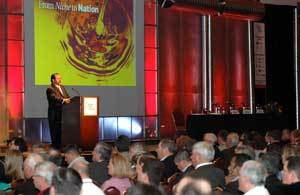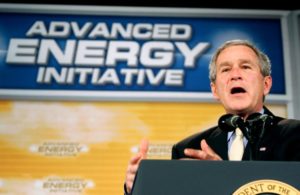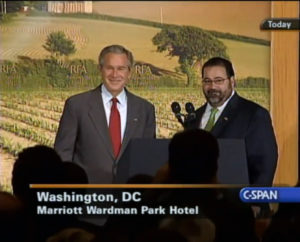SOTU and Switchgrass
 The U.S. ethanol industry had never been in such a perfect position for dynamic growth than it was at the start of 2006.
The U.S. ethanol industry had never been in such a perfect position for dynamic growth than it was at the start of 2006.
President George W. Bush was the strongest ally the industry had ever had in the White House. His 2006 State of the Union address was primarily focused on terrorism, with the memory of 9/11 still fresh in the mind of the nation. His second focus was on keeping America competitive.
“Keeping America competitive requires affordable energy. And here we have a serious problem: America is addicted to oil, which is often imported from unstable parts of the world. The best way to break this addiction is through technology. Since 2001, we have spent nearly $10 billion to develop cleaner, cheaper, and more reliable alternative energy sources — and we are on the threshold of incredible advances.”
President Bush announced the Advanced Energy Initiative, a 22-percent increase in clean-energy research at the Department of Energy to push for breakthroughs in powering both buildings and automobiles.
“We will increase our research in better batteries for hybrid and electric cars, and in pollution-free cars that run on hydrogen. We’ll also fund additional research in cutting-edge methods of producing ethanol, not just from corn, but from wood chips and stalks, or switch grass. Our goal is to make this new kind of ethanol practical and competitive within six years.”
The president’s greater goal was to replace more than 75 percent of our oil imports from the Middle East by 2025. “By applying the talent and technology of America, this country can dramatically improve our environment, move beyond a petroleum-based economy, and make our dependence on Middle Eastern oil a thing of the past.”
Ethanol had Arrived
 The 2006 National Ethanol Conference held in February in Las Vegas was a celebration of both the landmark policy achievements in 2005 and the Renewable Fuels Association’s 25th anniversary.
The 2006 National Ethanol Conference held in February in Las Vegas was a celebration of both the landmark policy achievements in 2005 and the Renewable Fuels Association’s 25th anniversary.
“My friends, ethanol has arrived,” said RFA president and CEO Bob Dinneen in his State of the Industry address that year. “The state of the ethanol industry is sound, and its future is bright. Ethanol has moved from a niche source of octane in the Midwest to a national and ubiquitous component of the U.S. transportation fuels market. Ethanol today is blended in more than a third of the nation’s gasoline supply.”
“It’s just the start,” Dinneen said. “The Energy Policy Act of 2005 will someday be seen as the bill that ushered in a new era in America’s economic development replacing a carbon economy with a more sustainable carbohydrate economy.”
RFA Chairman Ron Miller with Aventine Renewable Energy in Pekin, Illinois said the industry was growing to meet the new demand. “Currently there are 95 ethanol refineries capable of producing more than 4.3 billion gallons of ethanol every year,” he said, “in addition 29 refineries are under construction and nine plant expansions promise more than 1.5 billion gallons of additional capacity in the very near future.”
 Environmental Protection Agency Administrator Steve Johnson and Agriculture Secretary Mike Johanns both spoke at the National Ethanol Conference that year. Johanns announced the availability of $176.5 million in loan guarantees and almost $11.4 million in grants to support investments in renewable energy and energy efficiency improvements by agricultural producers and small businesses. At the same time, the Department of Energy announced $160 million in cost-shared funding over three years to construct up to three biorefineries in the United States. “The whole idea behind this is to support investments in renewable energy by ag producers and small businesses,” said Johanns. “The ethanol industry is so encouraging these days and with the president putting an exclamation point behind it at his State of the Union address, I would say that the future looks very good.”
Environmental Protection Agency Administrator Steve Johnson and Agriculture Secretary Mike Johanns both spoke at the National Ethanol Conference that year. Johanns announced the availability of $176.5 million in loan guarantees and almost $11.4 million in grants to support investments in renewable energy and energy efficiency improvements by agricultural producers and small businesses. At the same time, the Department of Energy announced $160 million in cost-shared funding over three years to construct up to three biorefineries in the United States. “The whole idea behind this is to support investments in renewable energy by ag producers and small businesses,” said Johanns. “The ethanol industry is so encouraging these days and with the president putting an exclamation point behind it at his State of the Union address, I would say that the future looks very good.”
The day before the ethanol conference kicked off President Bush had been in Milwaukee, Wisconsin touting renewable energy in general, and ethanol in particular.
 Now, we’re on the edge of advancing additional ethanol production. New technology is going to make it possible to produce ethanol from wood chips and stalks and switch grass, and other natural materials. Researchers at the Energy Department tell me we’re five or six years away from breakthroughs in being able to produce fuels from those waste products. In other words, we’re beginning to — we’re coming up with a way to make something out of nothing. And this is important because it’s — economics are such that it’s important to have your ethanol-producing factories or plants close to where the product is grown.
Now, we’re on the edge of advancing additional ethanol production. New technology is going to make it possible to produce ethanol from wood chips and stalks and switch grass, and other natural materials. Researchers at the Energy Department tell me we’re five or six years away from breakthroughs in being able to produce fuels from those waste products. In other words, we’re beginning to — we’re coming up with a way to make something out of nothing. And this is important because it’s — economics are such that it’s important to have your ethanol-producing factories or plants close to where the product is grown.
That’s why E85 has spread throughout the Midwest, that’s where you’re growing the corn. Pretty soon, you know, if you’re able to grow switch grass and convert that into ethanol, then you’re going to have availability for ethanol in other parts of the country. And one of the goals is to make sure that ethanol is widespread. If we want to affect our consumption of oil, we want ethanol to be readily available for consumers outside certain parts of the — certain regions of the country.
Commander in Chief Cheers on Ethanol Industry
 President Bush was all in for ethanol and he wanted the country to know it. The president wanted to talk to ethanol producers, and it became Bob Dinneen’s job to make that happen.
President Bush was all in for ethanol and he wanted the country to know it. The president wanted to talk to ethanol producers, and it became Bob Dinneen’s job to make that happen.
On April 25, 2006, on a stage at the Marriott Wardman Park Hotel in Washington, D.C., Dinneen introduced President George W. Bush as “the most pro-ethanol president in history” to a relatively small group of ethanol supporters as well as the national media. The president wanted to talk about the administration’s plan to confront high gas prices and the part that renewable fuels would play.
Gas was averaging $2.90 a gallon, up 16 percent from the previous month and 31 percent from 2005. Twenty-five states had already banned the use of MTBE as an oxygenate in reformulated gasoline which was being replaced by ethanol. “And I appreciate the role the ethanol producers are playing to meet this challenge,” said President Bush. “You’re playing a vital role.”
But Bush saw ethanol playing an even bigger role going forward. “I set a goal to replace oil from around the world. The best way and the fastest way to do so is to expand the use of ethanol,” Bush said, launching into what could have been an audition for the industry’s new spokesperson.

President George W. Bush addresses the Renewable Fuels Association Tuesday, April 25, 2006, at the Marriott Wardman Park Hotel in Washington, D.C. White House photo by Paul Morse
Ethanol is good for the environment. I keep emphasizing that we can be good stewards of our environment and, at the same time, continue with our economic expansion. And ethanol will help meet that strategy. You don’t have to choose between good environment and good economics. You can have both by the use of technology. And ethanol is an example of what I’m talking about.
And ethanol is good for drivers. Ethanol is home-grown. Ethanol will replace gasoline consumption. It’s a good–ethanol is good for the whole country.”
It may have sounded like a sales pitch, but every word was true. As Iowa Senator Chuck Grassley would often say, misquoting the Campbell’s soup “mm, mm, good” slogan, ethanol was “good, good, good.”